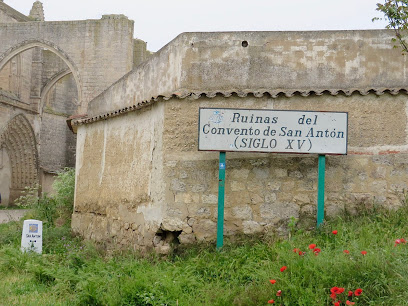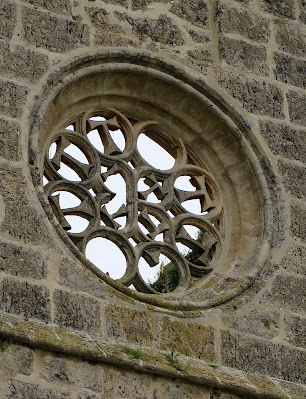At 6:30 we left Hontanas enveloped in mist. Many other pilgrims were also departing then. Our destination was the 13th c. Ermita de San Nicolas near the town of Itero de la Vega.
On our previous visit to this site, the niches contained objects and mementos such as bread, prayer cards, and even an empty wine bottle. Above each recess hung a shell with the Tau symbol, which identified the Order.
This year the Tau shells were gone and the niches contained handwritten notes held down by stones. Even though the tradition of the space had changed, it was still an ideal spot for an ex-voto. Of the 4 remaining, I left the bladder.
Architectural features found among the ruins:
Mid-morning we reached Castrojeriz, where we stayed in 2011 and explored the medieval castillo that overlooks the town.
Iglesia de Santa Maria del Manzano (Church of Saint Mary of the Apple) is on the way into Castrojeriz.
A bar next to the church provided a welcome breakfast break for many walkers.
Walking through the main street of Castrojeriz
This skull image was on a wall by Iglesia de Santo Domingo --
"O Mors" = "Oh Death" in Latin
This year the castillo was covered in fog when we arrived to town. However, by the end of our bar break, the mist had cleared and the castle emerged.
Outside Castojeriz, there's a steep incline to reach another plateau of the Meseta. Flowers lined the path as they had since Burgos.
The Meseta has its own special beauty.
A handpainted sign for Albergue La Mochila in Itero de la Vega
The albergue at the 13th c. Ermita de San Nicolas where we stayed is managed by an Italian Confaternity -- volunteers stay for a few weeks at a time. The building resonated history with its Romanesque stone walls and wood ceiling. There was no electricity, so the evening meal was served by candlelight. Very medieval!
Waiting in the shade until the albergue opened
View of St. Nicholas from the bridge down the Road. In the back of the chapel is a solar powered bathroom building.
On the way back from Itero de la Vega for an afternoon snack we stopped to look at this car, which had Camino shells & the words "Santiago de Compostela 2013" above the grill.
Bunk area on one end...
...the altar with icons on the other side
A skylight let in light.
During the night I walked outside to use the facility in the back building -- there was a big candle to guide my way to the front door left slightly ajar. The moon lit the path, and I didn't need to use my little flashlight until inside the bathroom.
Cyclists parked their bikes in the back by the vine covered wall.
Inscribed in the building's stone wall centuries ago was an estrella (star) mark -- it signifies the way of St. James, or following the field of stars (or the Milky Way).
Before the meal there was a washing of feet -- no photos allowed during this sacred ritual. The food included a pasta dish, spinach, and sliced potatoes -- all prepared with Italian culinary flare. The other pilgrims were mostly Italian and dinner conversation was in Italian, so Dad and I just listened. It became a language lesson trying to comprehend words that were similar to Spanish I know.





































No comments:
Post a Comment